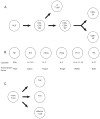Epigenetics and the adaptive immune response
- PMID: 22789989
- PMCID: PMC3508324
- DOI: 10.1016/j.mam.2012.06.008
Epigenetics and the adaptive immune response
Abstract
Cells of the adaptive immune response undergo dynamic epigenetic changes as they develop and respond to immune challenge. Plasticity is a necessary prerequisite for the chromosomal dynamics of lineage specification, development, and the immune effector function of the mature cell types. The alterations in DNA methylation and histone modification that characterize activation may be integral to the generation of immunologic memory, thereby providing an advantage on secondary exposure to pathogens. While the immune system benefits from the dynamic nature of the epigenome, such benefit comes at a cost - increased likelihood of disease-causing mutation.
Published by Elsevier Ltd.
Figures






References
Publication types
MeSH terms
Substances
Grants and funding
LinkOut - more resources
Full Text Sources
Other Literature Sources

